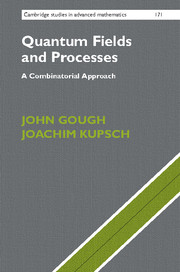
-
Select format
-
- Publisher:
- Cambridge University Press
- Publication date:
- 23 March 2018
- 12 April 2018
- ISBN:
- 9781108241885
- 9781108416764
- Dimensions:
- (228 x 152 mm)
- Weight & Pages:
- 0.62kg, 338 Pages
- Dimensions:
- Weight & Pages:
You may already have access via personal or institutional login
Book description
Wick ordering of creation and annihilation operators is of fundamental importance for computing averages and correlations in quantum field theory and, by extension, in the Hudson–Parthasarathy theory of quantum stochastic processes, quantum mechanics, stochastic processes, and probability. This book develops the unified combinatorial framework behind these examples, starting with the simplest mathematically, and working up to the Fock space setting for quantum fields. Emphasizing ideas from combinatorics such as the role of lattice of partitions for multiple stochastic integrals by Wallstrom–Rota and combinatorial species by Joyal, it presents insights coming from quantum probability. It also introduces a 'field calculus' which acts as a succinct alternative to standard Feynman diagrams and formulates quantum field theory (cumulant moments, Dyson–Schwinger equation, tree expansions, 1-particle irreducibility) in this language. Featuring many worked examples, the book is aimed at mathematical physicists, quantum field theorists, and probabilists, including graduate and advanced undergraduate students.
Reviews
'This book offers an excellent account of the probabilistic aspects of quantum theory, focused on the interplay between quantum field theory and quantum stochastic calculus. The text is highly accessible thanks to the careful choice of topics and the systematic use of elegant combinatorial and algebraic methods. This makes the book suitable for graduate level teaching and self-study. I highly recommend it as a timely addition to the classical literature on quantum probability.'
Madalin Guta - University of Nottingham
Contents
Metrics
Altmetric attention score
Full text views
Full text views help Loading metrics...
Loading metrics...
* Views captured on Cambridge Core between #date#. This data will be updated every 24 hours.
Usage data cannot currently be displayed.
Accessibility standard: Unknown
Why this information is here
This section outlines the accessibility features of this content - including support for screen readers, full keyboard navigation and high-contrast display options. This may not be relevant for you.
Accessibility Information
Accessibility compliance for the PDF of this book is currently unknown and may be updated in the future.


